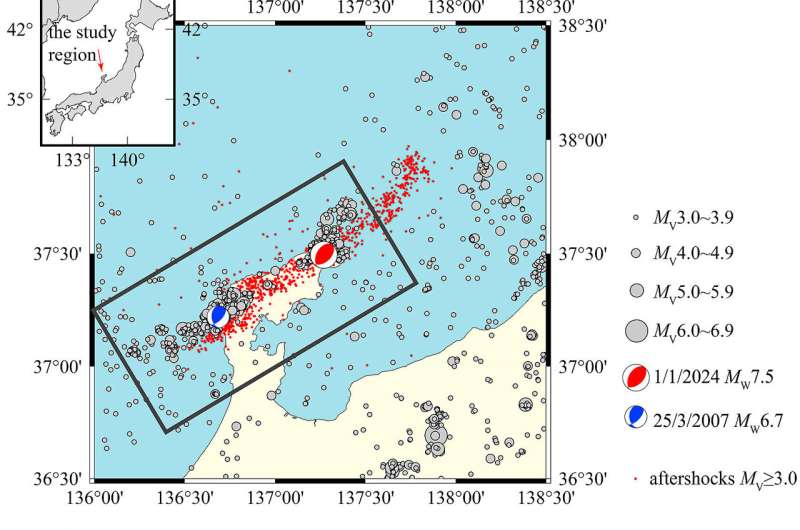This article has been reviewed according to Science X's editorial process and policies. Editors have highlighted the following attributes while ensuring the content's credibility:
fact-checked
proofread
Earthquake research traces the pace of an approaching 'seismic dragon king'

The 'Dragon King' theory was proposed based on the physics of complexity. According to this theory, 'Dragon King' events deviate from the power law distribution as a statistical outlier and, noticeably, have predictability.
On January 1, 2024, a significant moment magnitude Mw7.5 earthquake struck beneath Japan's Noto Peninsula. Prior to this seismic event, extensive studies had been undertaken in the region, primarily focusing on the earthquake swarm originating beneath the Noto Peninsula in November 2020.
Examining the scaling law of the selected sequence using data from the Japan Metrological Agency (JMA)'s focal mechanism catalog, a team of researchers from China identified the Mw7.5 earthquake as exhibiting characteristics of a 'seismic dragon king.'
"We applied the load-unload response ratio (LURR) to analyze earthquakes in close proximity to the Noto Peninsula, where pre-mainshock seismicity primarily delineated the aftershock zone of the 2007 Mw6.7 Noto-Hanto earthquake and the ongoing earthquake swarm," explains first author of the study, Yue Liu.
"The minimum magnitudes of smaller events gradually decreased from approximately Mv 2 to 0 between 1995 and 2006, likely attributed to the integration of the Hi-net and other dense seismic networks during this period."
The team reported their findings in Earthquake Research Advances.
The LURR method, proposed by Xiangchu Yin, who serves as the senior and co-corresponding author of this study, has seen successful application in various earthquakes globally.
This approach, grounded in damage mechanics, leverages seismic event responses to tidal stress fluctuations induced by celestial bodies like the sun and moon to gauge the mechanical state of the medium. Liu, a student of Yin, observed a precise alignment between the variation in LURR preceding the Mw7.5 earthquake and theoretical predictions.
Further investigations by the team are underway; Yin, however, cautioned about exercising prudence in interpreting findings from retrospective case studies, emphasizing the need to approach such analyses with caution despite their potential to enhance understanding of earthquake mechanics. Meanwhile, Yongxian Zhang, another student of Yin and co-corresponding author, highlighted the prevalence of seismic swarms in China and worldwide.
More information: Yue Liu et al, Tracing the pace of an approaching 'seismic dragon king': Additional evidence for the Noto earthquake swarm and the 2024 MW 7.5 Noto earthquake, Earthquake Research Advances (2024). DOI: 10.1016/j.eqrea.2024.100290
Provided by KeAi Communications Co., Ltd.




















